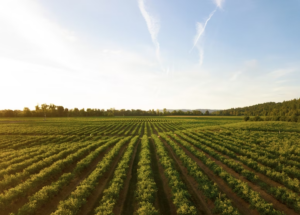
The Environmental Benefits of Alternative Crops: A Look at Sustainable Farming Systems
By Edrian Blasquino
Have you ever considered the environmental impact of your grocery list? It turns out, the food on your plate can have a bigger footprint than you think. But fear not, eco-conscious consumers! There’s a revolution brewing in the fields, and it’s all about alternative crops.
These aren’t your grandma’s tomatoes and turnips. We’re talking about a dazzling array of plants with the potential to transform our agricultural landscape – and for the better. So, ditch the guilt and dive into the world of sustainable farming with a fresh perspective on what grows on our plates.
Why Alternative Crops?
Monoculture farming—cultivating a single crop over vast areas—has been the agricultural norm for decades. While efficient, it’s taken a toll on the environment. Here’s how:
Soil Depletion
Imagine constantly taking vitamins from your body without replenishing them. That’s what happens to soil when the same crop is grown repeatedly. Alternative crops, with their diverse needs, help replenish nutrients and keep the soil healthy.
Water Woes
Water is a precious resource, and traditional farming can be incredibly thirsty. Certain alternative crops, like hemp, require significantly less water to thrive, making them ideal for drier regions.
Pesticide Problems
Monocultures are sitting ducks for pests. Farmers often resort to heavy pesticide use, which harms beneficial insects and pollutes soil and water. Alternative crops can disrupt pest life cycles, reducing the need for chemical interventions.
Alternative Crops to the Rescue!
Now that we understand the “why,” let’s explore the “what.” Here are some alternative crops with the potential to change the game:
- Hemp: This versatile plant is a superstar. From clothing and building materials to biofuels, hemp boasts a wide range of uses. Plus, it grows quickly and requires minimal water – a win-win!
- Industrial Hemp: Don’t confuse this with its psychoactive cousin, marijuana. Industrial hemp contains minimal THC, the psychoactive compound. But its potential for sustainable products, like cannabis topicals, is vast.
- Legumes: Think beans, lentils, and peas. These nitrogen-fixing champions not only provide a delicious protein source but also enrich the soil for other crops, naturally reducing reliance on fertilizers.
- Millet: This ancient grain is a powerhouse of nutrition, packing a punch of protein, fiber, and essential vitamins. Millet thrives in harsh conditions, making it a drought-resistant hero.
- Cover Crops: Planted between cash crops, these unsung heroes suppress weeds, improve soil fertility, and prevent erosion. They’re the ultimate teammates for a healthy agricultural system.
Beyond these superstars, the world of alternative crops is brimming with potential. Quinoa, with its complete protein profile, is a nutritional powerhouse. Foxtail millet, another ancient grain, boasts a delightful nutty flavor and impressive versatility. Even perennial crops, like asparagus and artichokes, are gaining traction for their reduced environmental impact and long-term yields. The possibilities are truly endless!
Sustainable Farming Systems: A Symphony of Nature
Alternative crops are just one piece of the puzzle in sustainable farming. Sustainable farming systems, like regenerative agriculture, combine various practices that benefit the environment, the soil, and our food supply.
Here are some of the key components of sustainable farming:
- Crop Rotation: Planting different crops in sequence helps to replenish nutrients in the soil and reduce pest and disease problems.
- Composting: Composting food scraps and yard waste creates a nutrient-rich amendment that can be added to soil, improving its fertility and health.
- Water Conservation: Sustainable farming systems use water-saving techniques, such as drip irrigation, to ensure that every drop counts.
- Wildlife-Friendly Practices: Creating habitats for pollinators and beneficial insects on farms helps to improve crop yields and reduce the need for pesticides.
The Ripple Effect: How You Can Cultivate Change
The world of agriculture is on the cusp of a transformation. By embracing alternative crops and sustainable practices, we can rewrite the narrative. But this shift isn’t just about farmers and policymakers – it’s about all of us.
Here’s how you can become a champion for change:
Be a Conscious Consumer
The power lies in your grocery cart! Seek out products that showcase alternative crops or hail from farms with established sustainable practices. Through these choices, you demonstrate your support for eco-conscious growers, potentially inspiring others to join in the movement toward a greener future.
Embrace the Local Bounty
Visit your local farmers market and strike up a conversation with the farmers. Ask about their practices and let them know you value sustainability. Supporting local agriculture strengthens your community and reduces the environmental impact of long-distance food transportation.
Spread the Knowledge
Talk to your friends and family about the importance of alternative crops and sustainable farming. Share your newfound knowledge and inspire others to make conscious choices.
Get Hands-On
Many community gardens, farms, and nature parks offer opportunities to observe sustainable practices and get your hands dirty—literally. Dig into the soil, plant those alternative crops, and witness the power of sustainability in action. The experience will be enriching and leave you feeling empowered.
Final Thoughts
Change starts small. By making informed choices and advocating for a healthier food system, you become a vital part of the solution. Let’s cultivate a world where delicious food and environmental responsibility go hand-in-hand. Together, we can rewrite the recipe for a sustainable tomorrow, one delicious plate at a time.
 About the author: Edrian is a college instructor turned wordsmith, with a passion for both teaching and writing. With years of experience in higher education, he brings a unique perspective to his writing, crafting engaging and informative content on a variety of topics.
About the author: Edrian is a college instructor turned wordsmith, with a passion for both teaching and writing. With years of experience in higher education, he brings a unique perspective to his writing, crafting engaging and informative content on a variety of topics.
Now, he’s excited to explore his creative side and pursue content writing as a hobby.